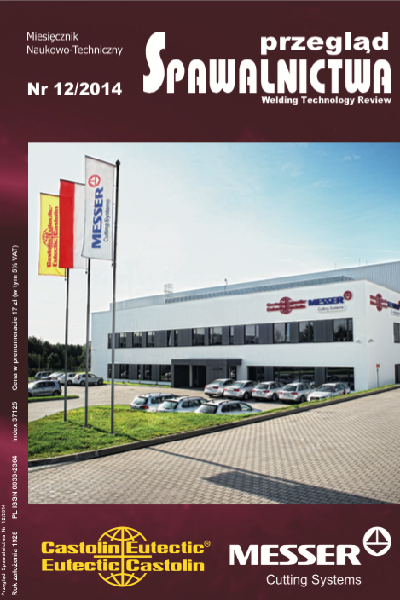Influence of diffusible hydrogen on brittle fracture resistibility of metal in heat-affected zone of high-strength carbon steel
Main Article Content
Abstract
Abstract
Influence of diffusible hydrogen on the change of brittle fracture resistibility and mode of HAZ metal of welded joints on high-strength steels with 0,58% and 0,65% carbon content has been studied. Methods of simulation of thermal cycle of welding, saturation of model samples by hydrogen and their subsequent testing at bending were used to determine the influence of dif- fusible hydrogen on stress intensity factor К1С of HAZ metal. Metal microstructure in HAZ overheated zone and model sample fractures after testing were studied. It is shown that high-strength carbon steels and their joints have high susceptibility to embrittlement in the presence of hydrogen. Metal structural condition plays an essen- tial role here. Optimum structure of HAZ metal is bainitic- martensitic one at more than 1 ratio of structural components. At saturation of joints by diffusion hydrogen occurring in welding, their brittle fracture susceptibility increases. To lower metal embrittlement, it is necessary to apply special welding processes, at which hydrogen saturation of deposited metal is minimum (less than 0,2 ml/100g) or techniques, allowing removal of diffusible hydrogen from the metal after welding.
Streszczenie
W artykule zaprezentowano wyniki badań poświęconych opisaniu wływu wodoru dyfundującego na kruche pękanie w SWC złączy spawanych wysokowytrzymałej stali o stężeniu masowym węgla 0.58% oraz 0,65%. Do określenia współczynnika intensywności naprężeń KIC w SWC użyto metod symulacji cyklu termicznego spa- wania z możliwością nasycania wodorem SWC. Przebadano mikrostrukturę przełomów w obszarze przegrzania w SWC próbek z symulatora cykli cieplnych spawania. Otrzymane wyniki wskazują, że złącza spawane stali o wysokiej wytrzymałości wykazują wysoką skłonność do pęknięć wodorowych. Właściwości struktury materiału odgrywają pod tym względem znaczącą rolę. Za optymalną strukturę w SWC uznaną bainityczno-martenzytyczną. Nasycenie złączy wodorem znacząco zwiększa ich skłonność do kruchego pękania. W celu obniżenia kruchości metalu w SWC koniecznym jest stosowanie niskowodorowych procesów spawania, w których nasycenie wodorem jest poniżej 0,2 ml/100g stopiwa lub technik pozwalających obniżenie stężenia wodoru po spawaniu w obszarze złącza.
Downloads
Article Details
Creative Commons CC BY 4.0 https://creativecommons.org/licenses/by/4.0/
Welding Technology Review (WTR) articles are published open access under a CC BY licence (Creative Commons Attribution 4.0 International licence). The CC BY licence is the most open licence available and considered the industry 'gold standard' for open access; it is also preferred by many funders. This licence allows readers to copy and redistribute the material in any medium or format, and to alter, transform, or build upon the material, including for commercial use, providing the original author is credited.
References
O. G. Kasatkin "Features of hydrogen embrittlement of high- strength steels in welding" Automatic welding, No. 1, s. 3-7, 1994.
I. V. Shvachko, A. V. Ignatenko "Model of hydrogen transportation by dislocations" Automatic welding, No.2, s.27-30, 2007.
A. V. Ignatenko, I. K. Pokhodnya, A. P. Paltsevich, V. S. Sinyuk "Dislocation model of hydrogen localizing of ductility in metals with BCC lattice" Automatic Welding, No.3, s. 22-27, 2012.
A. A. Gaivoronskiy, V. D. Pozdnyakov, V. A. Sarzhevskii, V. G. Vasilyev, V. Yu.Orlovskiy "Influence of thermodeformational cycle of surfacing on structure and properties of higher strength railway wheels at their reconditioning, Automatic welding, No.5, s. 22-26, 2010.
A. A. Gaivoronskiy, V. D. Pozdnyakov, L. I. Markashova "Influence of deposited metal composition on structure and mechanical properties of reconditioned railway wheels" Automatic welding, No. 8, s. 18-24, 2012.
DSTU GOST 10791 Whole-rolled wheels. Technical conditions.
GOST 1050 High-quality structural carbon steel.
New methods of evaluation of metal resistivity to brittle fractu-
re, Ed. by Yu. N. Robotnov. Mir, s. 439, 1972.
M. Kh. Shorshorov, T. A. Chernyshova, A. I. Krasovskiy "Metal testing for weldability" Metallurgia, s. 240, 1972.
GOST 25.506 Methods of mechanical testing of metals.
V. I. Makhnenko, T. V. Koroleva, I.G. Lavrinets "Influence of microstructural changes on hydrogen redistribution in fusion welding of structural steels" Automatic welding, No. 2, s. 7-13, 2002.
V. F. Grabin, A. V. Denisenko "Metals science of welding low and medium-alloyed steels" Naukova Dumka, s. 272, 1978.
A. A. Gaivoronskiy "Influence of diffusible hydrogen on resistivity to delayed fracture of high-carbon steel welded joints" Automatic welding, No.5, s.15-21, 2013.
